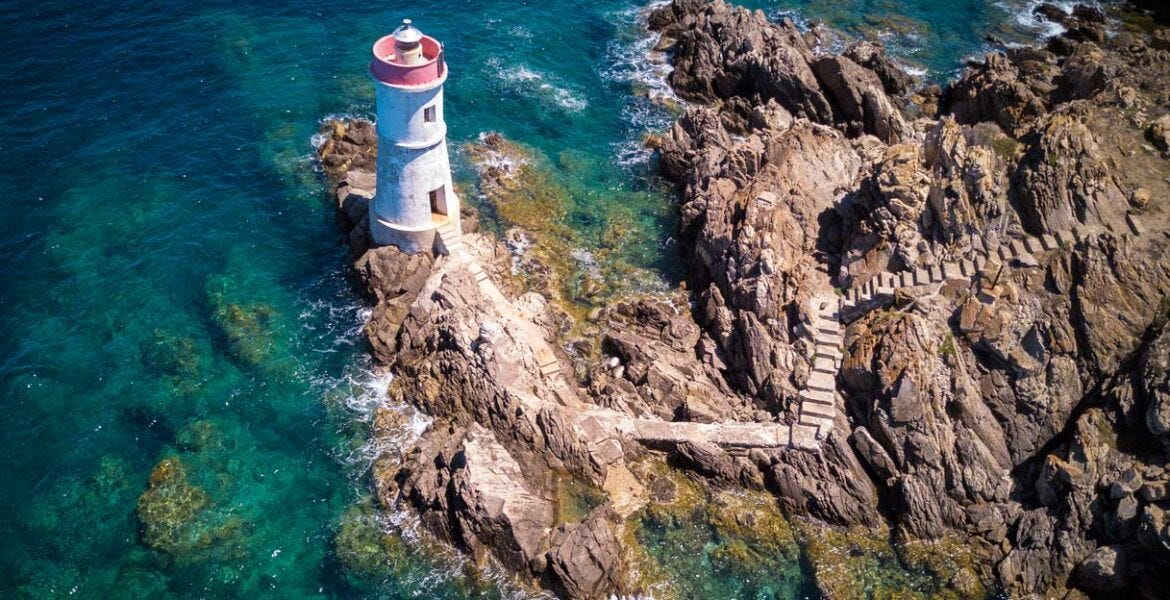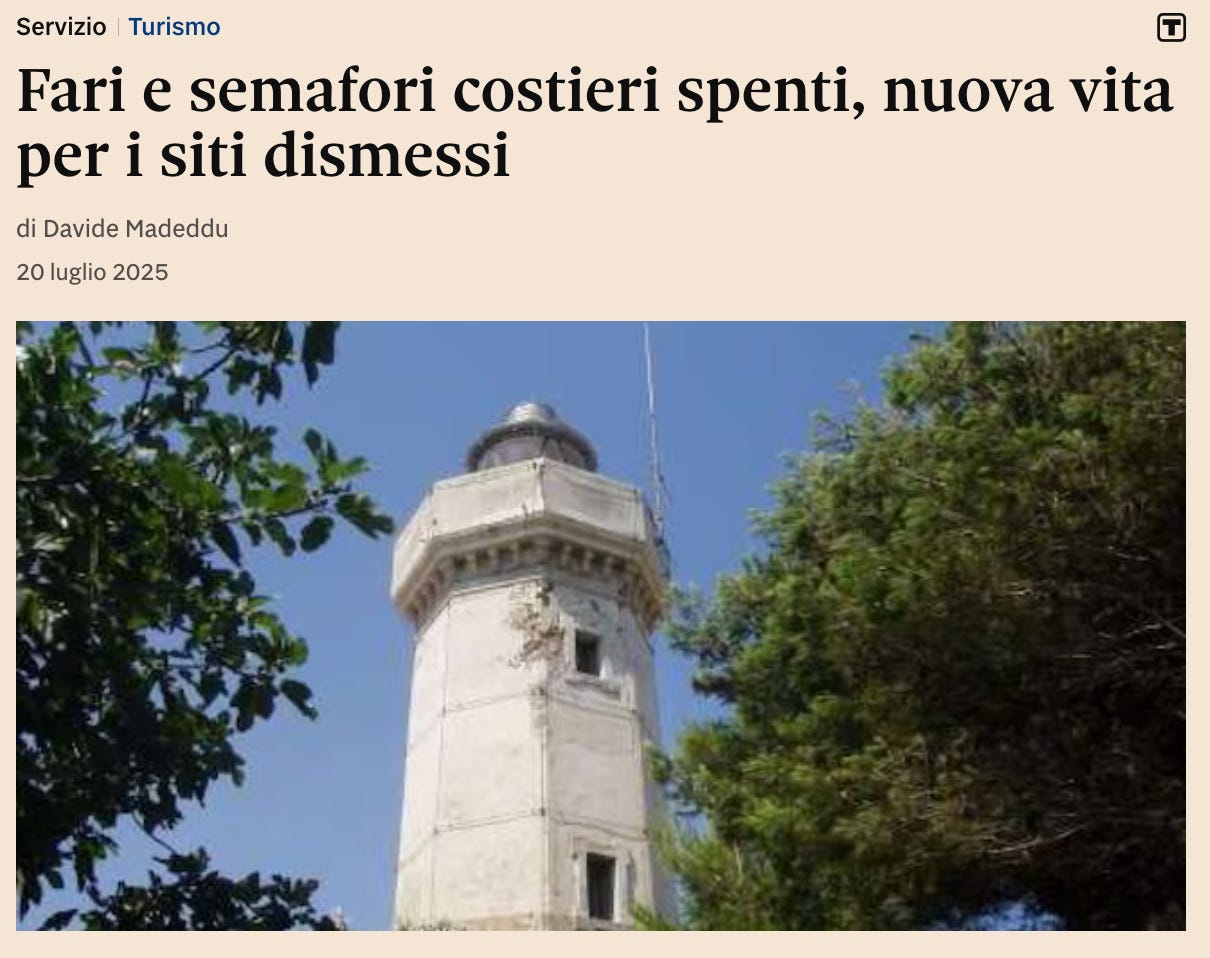Romantic Illusion, Dim Reality
Lighthouses, barracks and castles: poetic state-owned heritage, irresistible to the media – but harder to revive than you'd think
Illusione a luci spente
Fari, caserme e castelli: il demanio romantico che piace ai giornali, ma meno alla realtà
L’articolo pubblicato oggi su Il Sole 24 Ore (“Fari e semafori costieri spenti, nuova vita per i siti dismessi” di Davide Madeddu, 20 luglio 2025) ripropone una narrazione suggestiva: quella della rinascita di fari, caserme e castelli demaniali, trasformati in resort, spazi culturali o rifugi per un turismo lento e sostenibile. L’idea è poetica, l’effetto immediato. Ma se si va oltre il titolo e si fa un po’ di fact-checking sul territorio, il quadro cambia.
Molti dei progetti citati sono ipotesi ferme da anni, alcuni mai partiti, altri ritirati, e pochissimi quelli effettivamente realizzati. Eppure ogni estate – complici la stagione e la fame di buone notizie – queste storie vengono rilanciate come successi già compiuti.
Il programma “Valore Paese – Fari”
Dal 2015, l’Agenzia del Demanio, in collaborazione con Difesa Servizi, promuove il progetto “Valore Paese – Fari”, con l’obiettivo di affidare in concessione lunga (fino a 50 anni) strutture pubbliche costiere dismesse o inutilizzate. Un’ottima iniziativa in teoria, ma con esiti reali molto più limitati di quanto raccontato.
Cosa succede davvero
Molti progetti, anche tra quelli assegnati, non sono mai stati realizzati. I motivi sono noti a chi lavora sul campo:
Costi di restauro molto superiori alle stime iniziali;
Vincoli paesaggistici e architettonici estremamente rigidi;
Tempi lunghissimi per permessi e approvazioni;
Edifici inaccessibili, privi di infrastrutture minime (acqua, elettricità, strade);
Modelli di business insostenibili senza investimenti milionari.
Risultato? In molti casi i concessionari si sono ritirati, o sono bloccati da anni in una palude tecnico-amministrativa.
Casi concreti (spesso citati, mai realizzati)
Faro di Punta Imperatore (Ischia): assegnato nel 2016. Dopo ritardi, ricorsi e proteste, è ancora in restauro nel 2025. Nessuna apertura al pubblico.
Faro di Capo Grosso (Levanzo): progetto annunciato nel 2016. Siamo nel 2025 e resta sulla carta.
Faro di Brucoli (Siracusa): inserito tra i “casi virtuosi” anche oggi, ma mai attivato. Tutto fermo.
Faro di San Domino (Tremiti): affidato a un gruppo tedesco. Non esiste alcun segno tangibile di attività operativa.
Faro di Capo d’Orso (Maiori): affidato al WWF nel 2016 per attività scientifiche e culturali. Anche questo, mai partito davvero.
E questi sono i casi che tornano regolarmente nei media, ogni volta con un nuovo taglio narrativo, ma senza aggiornamenti reali.
L’estero? Non è sempre meglio
In Francia, i fari sono gestiti da enti pubblici o fondazioni per finalità culturali, con forti sostegni pubblici.
In Scozia, solo pochissimi fari sono diventati B&B o ritiri creativi, dove esiste un mercato reale e sostenibile.
In Spagna, molte torri costiere sono tornate abbandonate dopo tentativi falliti per via degli stessi problemi italiani: location inaccessibili e costi esorbitanti.
Quindi non vale la pena?
Al contrario: valorizzare il patrimonio dismesso è fondamentale. Ma bisogna farlo con realismo, risorse adeguate e una narrazione più onesta.
Serve:
Una due diligence tecnica e finanziaria seria, prima di presentare progetti.
Investitori strutturati, non semplici appassionati.
Collaborazione istituzionale efficace e costante.
Tempi lunghi e capitale paziente.
E soprattutto serve dire la verità nei media: che un faro non è un boutique hotel, ma un progetto complesso con margini stretti e rischi elevati.
Sì, i fari sono belli. Le caserme storiche affascinano. I castelli abbandonati emozionano. Ma senza infrastrutture, accesso e investimenti adeguati, rimangono solo fotografie poetiche.
Ogni volta che rilanciamo titoli su "rinascite" che non sono mai iniziate, traduciamo il romanticismo in disinformazione.
Accendiamo la luce – anche sui bilanci, non solo sui tramonti.
Romantic Illusion, Dim Reality
Lighthouses, barracks and castles: poetic state-owned heritage, irresistible to the media – but harder to revive than you'd think
Today’s article in Il Sole 24 Ore (20 July 2025) is a familiar summer headline: “Coastal lighthouses and signal stations find new life.” Once again, we read about military forts, abandoned lighthouses, and crumbling castles being transformed into hotels, cultural hubs or artist residencies. The idea is magnetic. The photos are gorgeous. The truth? Much harder to illuminate.
Because while the narrative suggests success stories, most of these projects are either stuck, abandoned, or never moved beyond the press release. What’s reported as “about to open” has often been “on hold since 2016.”
The “Valore Paese – Fari” Program
Launched in 2015 by Italy’s State Property Agency (Agenzia del Demanio) in partnership with Difesa Servizi, the “Valore Paese – Fari” initiative was designed to lease out unused public coastal assets (primarily lighthouses) to private investors under 50-year concessions. The goal? Redevelopment through tourism, culture, or hospitality – with zero public expenditure.
It’s a sound idea on paper. But execution has proved more fragile than the stones it hopes to restore.
What really happens
Many awarded projects have never been completed, or were quietly withdrawn by the leaseholders themselves. Why?
Restoration costs are dramatically underestimated;
Heritage and environmental restrictions are severe;
Permits and approvals often take years;
Locations are often inaccessible by road, lacking water, sewage, or electricity;
No real business model without millions in capital and a very long time horizon.
In short: the idea is romantic, but the operations are brutally complex.
Recurring cases, but rarely complete
The same sites appear every year in press coverage. A few examples:
Punta Imperatore Lighthouse (Ischia): awarded in 2016. Work stalled for years amid protests and appeals. Still under renovation in 2025. Not yet open.
Capo Grosso Lighthouse (Levanzo): a highlight in many articles since 2016. Still not functional. Just drawings.
Brucoli Lighthouse (Sicily): included in this week’s press coverage. As of July 2025, no confirmed activity.
San Domino Lighthouse (Tremiti Islands): awarded to a German firm. Still unopened. No public updates.
Capo d’Orso Lighthouse (Amalfi Coast): granted to WWF in 2016. Plans for a marine observatory announced. Still nothing launched.
These are not hidden failures – they are the exact same projects listed as “successful transformations” every summer, without real fact-checking.
What about abroad?
In France, most lighthouses are managed by public foundations for cultural, not commercial, use – with public funding.
In Scotland, a few have become boutique B&Bs – only where roads exist and the niche market (birdwatching, retreats) makes sense.
In Spain, many towers were granted under similar schemes… and now sit abandoned again due to costs and access issues.
The lesson? There is no scalable model. Only very specific cases work – and only with access, capital, and sustained partnerships.
So is it still worth trying?
Yes – but only with full transparency and realism. These aren’t light hospitality projects. They are multi-year, high-risk ventures in extreme locations.
What’s needed:
Deep technical and financial due diligence;
Experienced investors and operators;
Close cooperation with public institutions and regulators;
Long timelines, patient capital – and clear exit strategies.
And above all: the media needs to be honest about what these projects entail – not just show drone shots and dreams.
Italy’s disused public heritage deserves regeneration. But the real obstacle isn’t money or ideas – it’s the gap between media narrative and operational reality.
Every time we repackage the same projects as “coming soon”, we inflate expectations, mislead local communities, and risk discouraging the serious players who could really make a difference.
Romance is fine. But the real light needs to shine on the business plan.



